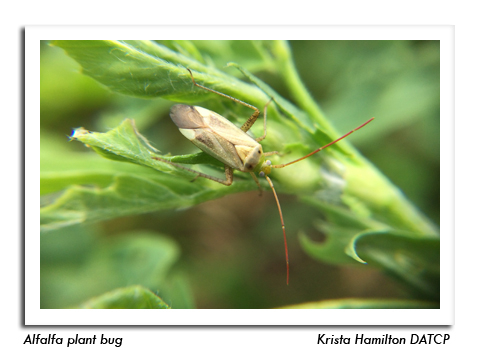
 |
|
|
Forages & Grains
Volume 65 Number 10 Date 07/08/2020 POTATO LEAFHOPPER - Counts in 21% of the fields surveyed July 1-8 were above the economic threshold of 2.0 leafhoppers per sweep for alfalfa 12 inches and taller. The highest averages of 2.0-3.3 per sweep were recorded in in Dane, Grant, Iowa, Richland, Rock and Sauk counties, where moderate hopperburn injury was evident in fields with significant populations. The average across all 40 sites sampled was 1.5 per sweep. Potato leafhopper pressure has also reportedly increased in fruit and vegetable crops since late June. PEA APHID - Levels of this insect vary considerably by region of the state. Surveys in southern Wisconsin from Grant to Dodge County found low counts of less than 3.0 aphids per sweep. In contrast, counts in alfalfa across the east-central counties were much higher at 6-29 aphid per sweep. The regional average in Brown, Calumet, Fond du Lac, Kewaunee, Manitowoc, Outagamie, Sheboygan, Winnebago counties was 15 aphids per sweep. Routine scouting is recommended for eastern Wisconsin alfalfa until the second crop is harvested. PLANT BUG - Combined averages of the alfalfa and tarnished plant bugs varied from 0-1.6 per sweep and averaged 0.5 per sweep. These counts are considered extremely low for this pest. The economic threshold for combined counts of plant bug adults and nymphs is 5.0 per sweep. ALFALFA WEEVIL - Pupation is occurring statewide and feeding should subside shortly. Larval populations have declined markedly in the past two weeks, with <0.1 weevil per sweep now being the typical count. INDUSTRIAL HEMP EURASIAN HEMP BORER - The second flight of moths is beginning in southern Wisconsin. Industrial hemp growers who have observed EHB holes in plant stems are advised to scout their crops now to determine the approximate percentage of infested plants. If levels are high enough to warrant control, treatment of second-generation EHB larvae must target the newly hatched caterpillars before they bore into hemp stems and flowers. The most effective treatment window for EHB is brief and can only be determined by monitoring for the next emergence of EHB moths, which fly at dawn and dusk, and by closely inspecting plants for the tiny larvae. A list of organic products available for hemp pest control in Wisconsin can be found at https://datcp.wi.gov/Documents/IHPesticides.pdf. -- Krista Hamilton, DATCP Entomologist 
.jpg)
.jpg)

.jpg)
.jpg)
|
|
|